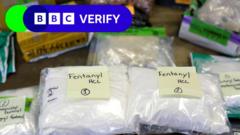As the fentanyl crisis continues to escalate in the United States, authorities face mounting pressure to address the transnational networks facilitating its entry. The drug primarily arrives from Mexico, largely produced using precursor chemicals sourced from China, raising complex questions about international cooperation and domestic policy effectiveness.
Infiltrating Borders: The Fentanyl Epidemic and its Transnational Ties

Infiltrating Borders: The Fentanyl Epidemic and its Transnational Ties
A comprehensive analysis of how fentanyl enters the United States, focusing on international trade dynamics, border security challenges, and the role of various countries.
The synthetic opioid fentanyl has emerged as a critical issue in the United States, claiming a staggering 74,000 lives due to opioid overdoses in 2023, according to the US Centers for Disease Control (CDC). This crisis has prompted the U.S. government to impose tariffs on Chinese goods, citing Beijing's insufficient efforts to curtail the export of chemicals essential for fentanyl production. Despite accusations against Chinese corporations, Beijing has retaliated with tariffs of its own.
Simultaneously, U.S. authorities have criticized Canada and Mexico for their purported inability to stop criminal gangs from smuggling fentanyl across the borders. While President Trump considered imposing tariffs on these neighboring countries, he postponed such actions after receiving pledges for enhanced border security.
Fentanyl, originally approved in the 1960s as a medical pain reliever, now significantly figures in the opioid-related death toll in the U.S. Often mixed with illicit drugs, it poses additional risks to users unaware of its presence. A mere two-milligram dose—which equals the size of a pencil tip—can prove lethal.
The primary route for fentanyl entering the U.S. is through Mexico, where drug cartels like the Sinaloa Cartel have been implicated in the trafficking of this deadly substance. In recent months, U.S. Customs and Border Patrol has reported seizing over 4,500 pounds (approximately 2,040 kg) of fentanyl, with 98% intercepted at the southwest border with Mexico. Less than 1% was confiscated from Canada.
Mexican cartels operate by sourcing precursor chemicals from China, manufacturing fentanyl in clandestine labs, and concealing shipments alongside legitimate goods to evade detection. In response to allegations of collusion between the Mexican government and drug cartels, President Sheinbaum has termed such claims as unfounded. However, Mexico's authorities did announce significant fentanyl seizures, with one operation netting an estimated 20 million doses.
Despite China's introduction of stricter narcotics controls in 2019, loopholes still permit the trade of essential chemicals for fentanyl synthesis, as traffickers exploit the legal gray areas. Evidence suggests that some Chinese chemical firms knowingly sell these substances to criminals for fentanyl production.
While China remains the primary supplier of fentanyl's precursor chemicals, the United States Drug Enforcement Administration (DEA) has identified India as an emerging source, with indictments recently filed against Indian chemical companies for alleged involvement in supplying materials for fentanyl production.
In terms of Canada’s role, while Trump's administration has criticized the country for its perceived facilitation of fentanyl trafficking, data reveals that a mere 0.2% of fentanyl seizures in the U.S. occur at the Canadian border. Canadian criminal organizations are reportedly getting increasingly involved in fentanyl production by importing necessary chemicals from China.
In a bid to combat this pressing issue, Canada has pledged a significant financial investment for enhancing border security and countering the fentanyl trade, underscoring the growing urgency of addressing the complex dynamics of drug trafficking as it relates to international relations and domestic safety policy.





















